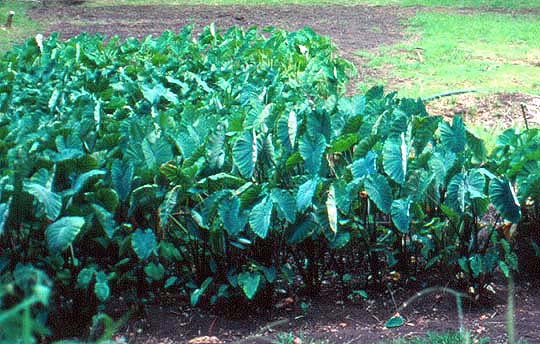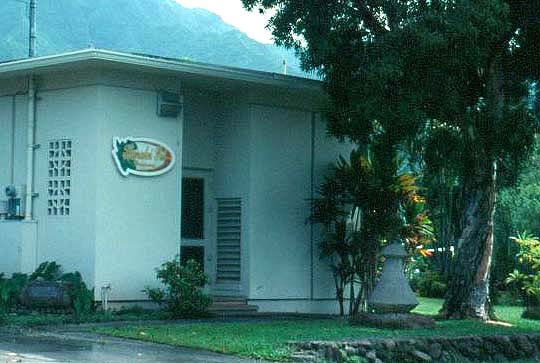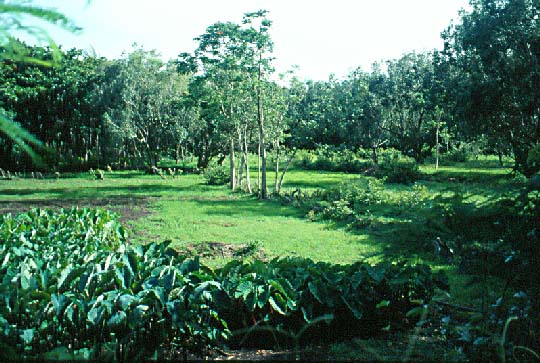 |
 |
 |
|||||||||
|
|
|
|
|
|
|
|
|
||||
|
|
|||||||||||
|
|||||||||||
|
|
Taro production was not only the economic mainstay of most Hawaiian communities, but was and is today an integral part of being Hawaiian. Taro is related to the gods, to the Islands themselves, and to human beings, forming a link between spiritual, environmental, and social worlds. Its importance cannot be understated. And as we have seen, Ha‘ena still retains large areas of relatively intact taro lands (lo‘i). Carlos talks about the dynamics of taro production and the Community's goals: "If things continue to go the way they're going," Carlos states, "the population of this island is going to be so great, that the Hawaiian people will not have areas in which they can propagate taro. And we're finding that taro is a very healthy food. So we want to develop an educational program to teach more people to use taro. "The price of taro is really high now. Taro commands 30 or 40 dollars for an 80 pound bag. For farmers, it is a profitable thing now. We see the continuing value of taro, not only as a foodstuff, but as a medicine, a spiritual activity. "Our long range plan is to restore these agricultural terraces, these lo‘i, back into working order, and replant them, and rebuild the stone walls, and take the jungle and bush that has grown over it, and remove them and use it as a way to continue to sustain the community by providing work and food--at the very least, food."
|
||
|
|
||
"In order to allow a restoration of lo‘i area, the State has certain steps that they must go through. One of the steps is to do archaeological excavation and mapping. Now they only had two archaeologists on staff, and it's a 17 acre parcel here that they'd have to map out, so they divided it into phase 1, phase 2, phase 3, and phase 4. What we did, without any kind of formal relationship established with the State Park system, we went in and provided labor to help to clear the walls of the lo‘i in order for them to shoot the lines to do the mapping. So we facilitated and enabled them to get the mapping done in a much quicker time than they would have been able to do if they had had to do all of that themselves. "This way, we demonstrated a good-faith working relationship: we were willing to put out the labor, put out the time to go and help them. This helped set things up for our request to be kahu, or stewards, for this area of the State Park. And we hope to build that relationship by proving, by our work and what we do, that we can be dependable and indeed are sincere about taking care of the place, to include the whole State Park."
|
||
|
|
||
|
"Right now, we're constrained to working in this one section of lo‘i. There is some taro planted there now. That's the seedbed of the taro that will be grown in all the rest of the terraces. This is a multi-generational task, it's not going to be done in my lifetime. My personal philosophy is that we clear, and clean, and plant one lo‘i. And then we go to the next, and clear, and plant, and maintain two. And as we get more and more people involved, we will expand and expand and expand, and pretty soon, in two or three generations, we'll have the whole place restored and planted, and the auwai's running again, and the water running through it. But it's a very, very long-term thing. "We have a lot to learn about how the water was distributed, how the work was distributed, how to interact as a people to get the jobs done that needed big groups of people to get done. And we're still struggling with interpersonal things. The biggest problem that we're dealing with is not the work on the ground, the actual planting and clearing--we have those skills. Our biggest issue is, how do you keep a community focused on a goal that is such a long-term goal, and keep them working together in relative states of harmony, and not be discouraged. You work on one lo‘i, and you see 17.5 acres of lo‘i that is overgrown, and you ask, 'how will we ever finish this, how will we ever do it?' "
|
||
|
|
||
|
"Already, there are areas that had been cleared and are re-growing back again. And there are people within our group that are saying, "hey, we have to go up there and cut those things back down again." Well, my personal opinion is, we bit off too much. Why don't we just finish this first lo‘i, and make it as perfect and functioning as we can get it at this time,. And then we'll go to the next one, and do that to the next one. "At the moment, some of our members are concerned that the young kinds of today, they don't want to know how to work in a taro patch any more, they don't want to come back and do this kind of work. And I try to tell them, just be patient, let's just try to do a little at a time, because all of the work that we have ahead of us is not just only working in the taro patch."
|
||
|
|
||
| |
| |
|
|
 |
| Ha'ena Home | Map Library | Site Map | Hawaiian Islands Home | Pacific Worlds Home |

|
|||
| Copyright 2001 Pacific Worlds & Associates • Usage Policy • Webmaster |
|||






